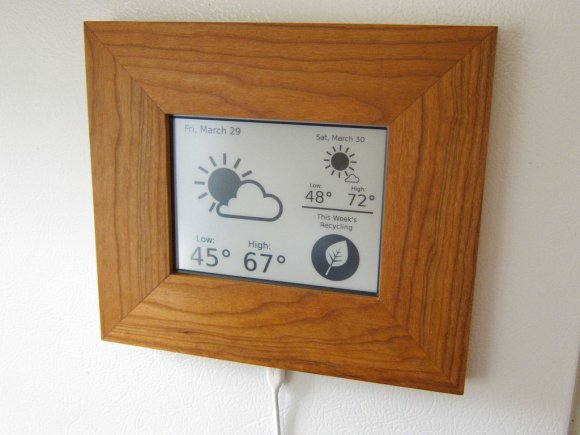
We’ve seen a fair number of hacks like this one that reuse a Kindle basically just for its ePaper display. [HaHaBird] has this device hanging on his refrigerator to display the weather and remind him about recycling day. It kind of make us wonder why we’re not seeing cheap ePaper modules on the hobby market?
The concept isn’t new, but [HaHaBird] does move it along just a little bit. He started by following the guide which [Matt] wrote after pulling off the original Kindle weather display hack. It uses a separate computer running a script that polls the Internet for weather data and generates a vector graphic like the one seen above. The Kindle then loads the image once every five minutes thanks to a cron job on the rooted device. But why stop there? [HaHaBird] tweaked the script to include a reminder about his municipality’s irregular recycling schedule.
Don’t overlook the quality of the hardware side of this hack. With its prominent place in the kitchen he wanted a nicely finished look. This was achieved by building a frame out of cherry and routing passages on the back to make room for the extension cable (so it could hang in landscape orientation) and a toggle to hold the Kindle firmly in place. Additional information on the build is available here.















The ED060SC4 modules are quite cheap ($40) on eBay. Problem is that they are not very easy to drive without specialized controller. I’m going to see if I can connect one to STM32L151, but haven’t finished the PCB yet.
Looking at the limited datasheets, the ED060SC4 doesn’t look too hard to drive, it’s maximum clock speed is 200kHz, well within the range of a simple AVR or PIC.
What’s harder is generating the 5 different voltages it needs and working out the exact protocol to address the pixels which this datasheet doesn’t actually say.
Here is the material I have found so far:
http://koti.kapsi.fi/~jpa/stuff/other/eink_information/
Generating the voltages is annoying, but not too difficult. The least documented thing seems to be the waveforms necessary: it seems that Vborder should be toggled to specific voltages in order to write either “white pixels” or “black pixels”. Some sources seem to indicate that one should balance the waveforms to not have any DC bias over long term, kind of like how you need to do with 7-segment LCD screens.
So, is the kindle the most hacker-friendly e-reader device out there? I would love to have a small linux computer with an eink display.
The Sony PRS-T1 and T2 run Android and are rootable.
Add the Nook SImple Touch to that list!
The Kobo Glo (and the newer models of the Kobo Touch) boot from an internal micro SD card, so it’s basically unbrickable. The Kindle is more widely hacked, because more people have them around, but they can be bricked if you’re not careful. Both the Kindle and the Kobo run Linux.
That’s a beautiful routing job in the frame; personally the only thing I’d change is the cable coming out of it, but that’s necessary I guess, unless he installed a battery pack there somehow, or punched a hole in his drywall.
Since they use no power for the screen, except when updating it, and the thing spends most of it’s time waiting for the cron job to tick around, the power usage must be quite low anyway, and I’m sure there’s a few tweaks to reduce it. I bet with a medium-sized battery pack he could get at least a week between charges, maybe more. Then he wouldn’t need the cable, and it’d look lovely.
Assuming it’s a Wifi model. All Kindles have Wifi right?
Excellent hack; I agree about ED060SC4 challenge – it’s not the protocol; it’s the analog part of pesky power requirements. I would not be surprised if there is an Arduino library already for printing to the ED060SC4 but again, coming up with those exotic voltages is a hassle IMHO. Back to the hack – love the idea and love the use of cron where Kindle pulls its own data.
I’m not sure what’s the point of buying an e-Ink display for $40+ when a complete Nook Simple Touch (with rechargeable battery) can be found for $60. Even cheaper are last generation Kindle and refurb Kobos and failed e-readers. But the Nook with its Android OS and existing hack community makes it soooo much simpler to hack around.
There are inexpensive modules for hobbyists. I’m currently working with this one:
http://www.embeddedartists.com/products/displays/lcd_27_epaper.php
It’s still a bit more complicated to drive than a simple LCD but it can be driven by SPI + PWM and optionally I2C if you want to temperature-adjust the timings.
Thank you so much for the tip!
Wow, this project looks great…
Has anyone gotten this project to work on the Kindle as a stand alone without the web server?
How about just getting a date/time to show up in big fonts without a server call?
Thanks again for the great post.
Anyone interested on hacking this LARGE & CHEAP e-paper equipped device?
http://www.banggood.com/Howshow-E-Note-Paperless-LCD-Writing-Tablet-Office-Family-School-Drawing-Graffiti-Toy-Gift-p-1070873.html?utmid=912
Obviously it IS NOT an epaper…thats why: No :) (Its just some kind of LCD which is presure sensitive and resetted by an short electric impulse – BTDT). Klaus.
Yes, I realized it some time after my comment …